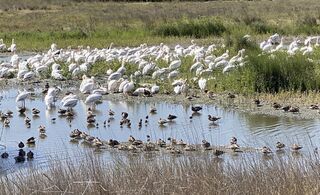Attention
Capture the Moment With Intentional Noticing
We miss a lot of cues in daily life when we aren’t paying attention.
Posted August 20, 2021 Reviewed by Davia Sills
Key points
- We miss a lot of cues in daily life when we aren’t paying attention and not using all of our senses to interpret behaviors and events.
- We are programmed to notice first and foremost what will keep us alive, even though the daily dangers we now face are far less critical.
- Intentional noticing can be learned and has big payoffs—benefitting the central nervous system, enhancing creativity, and deepening meaning.

We miss a lot of cues in daily life when we aren’t paying attention or using all of our senses to interpret behaviors and events. The consequence is missing out on much that connects us to our spirit, the natural world, and pleasures that are abundantly available without cost. That’s why resolving to consciously focus on what is plainly there in front of our eyes is both possible and refreshing, emotionally and physiologically.
I try to be a keen observer of human as well as animal behavior. Maybe it’s in my DNA, or perhaps I learned to notice as a byproduct of growing up on the streets of New York City where appraising your proximity to others might be critical to personal safety. It may explain why I became a psychologist, a student of human behavior, while also devoted to studying animal behavior.
These days, as I go about my daily life, I see people relying less and less on direct observation with their eyes and trusting what others think, report, and purport to know. Increasingly, they depend on social media, cameras, word of mouth, and other secondary sources of information. I see this as especially worrisome when people crossing a street fixate on their phones while reading or sending a message, an all too common theme.
Recently I walked a trail, cell phone in pocket, adjacent to an estuary on San Francisco Bay that is home to a variety of fresh and saltwater birds. Hiking is one of the outdoor activities that still ensures a modicum of safety as we wind through yet another COVID-19 variant’s assault. The walkers, runners, and bikers crossing my path seemed intent on their exercise goals and hardly seemed aware of the environment through which they passed. Occasionally a person with a long photo lens hanging from their neck stopped to photograph the rich array of feathered creatures on both sides of the trail. Were they focused on framing a shot, or were they birders actually studying the birds?
The mallard ducks crowded together in the tight freshwater channel fed by streams that began their journeys in the mountains, but the streams were quite dried up by mid-summer. The ducks rocked gently in very shallow waters surrounded by a field of mud drying in the sun. On the other side of a levee was San Francisco Bay, offering an outlet in the rainy season for the adjacent freshwater pond’s overflow. On the thin slice of land that separated parts of the bay, to my left was an enormous flock of pelicans huddled close to each other and smaller birds, darker in color, in an adjacent protected inlet. I suspected they were recent hatchlings guarded by their mothers.
Watching them for more than a couple of minutes caused some ruffling of feathers and murmuring within the group. I moved on. On the other side of the walkway, hundreds of identical small birds of a different type gathered together inches apart in some kind of a formation, all facing north. Side by side, row by row, they bobbed on the gentle waves like soldiers waiting for their orders.
Their placement didn’t seem accidental but serving some purpose that I didn’t understand. So I stood there, observing, to try to make sense out of the scene. In the meantime, no one else seemed to notice or care while walking or running past me, seemingly oblivious to what I found so fascinating. Moments later, I began to see a slight movement in the entire assembly, perhaps some fluttering of wings and low guttural sounds. Then I sensed energy present in the huge flock, which I interpreted as agitation, as if each and every bird was readying for action. A low hum followed, and I suspected the flock was readying for some change in their collective behavior. Mesmerized, I just stayed put and watched and waited for something to happen.
All at once, the entire flock took to the air and, in an immense symmetrical formation, flew in several circles, then off into the horizon. I’m not a bird watcher nor an ornithologist, and while I can’t explain what I saw, I definitely anticipated the action that occurred. I was paying attention, and the experience was breathtaking!
There is so much visual stimulation in our daily lives that it’s easy to disregard much of what is plainly in front of us to avoid being overwhelmed by too much media information. What happens when you stop to notice? Does it cause anxiety? Or does insight surface, maybe a solution to a problem? Perhaps it’s an opportunity to simply be aware of what is good at that moment, possibly a feeling of gratitude for someone or something. It might simply be thankfulness for being just where you are, then and there.
Noticing and seeing have more to do with intentional focus than with the functioning of the brain’s visual cortex. Day to day, we tend to concentrate on the business at hand, whatever it is, and any extraneous information tends to get set aside unnoticed. Ironically, this actually has some evolutionary advantages. In the days of our ancient ancestors, taking time to see and wonder about a gathering of birds could cost you your life. Survival was the name of the game, and unless the birds offered some crucial medicinal or nutritional benefit, better to stay vigilant for cues about a hungry predatory animal lurking nearby.
We are programmed to notice first and foremost what will keep us alive, even though the daily dangers we now face are far less critical, though there is much in the world that is troubling and beyond our control. The pleasant, more relaxed behaviors that make us feel good and slow down our pulse, signaling peace and safety, generally get little attention. Our lengthy, never-ending priority lists and projects feel urgent and demand attention before what may be perceived as frivolous—seeing the beauty around us. Though the evolutionary pull is strong, intentional noticing is a behavior that can be learned and has big payoffs, benefitting the central nervous system, enhancing creativity, and deepening meaning.
This article is partially based on a chapter in the author’s book, Inward Traveler: 51 Ways to Explore the World Mindfully.




